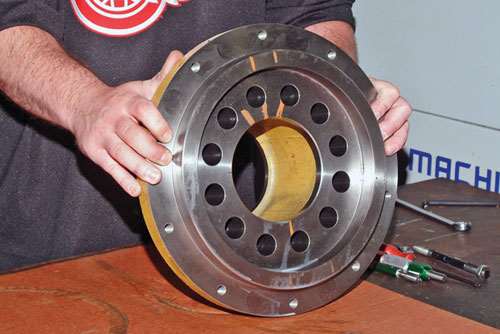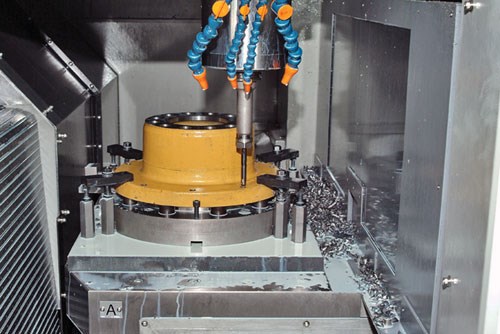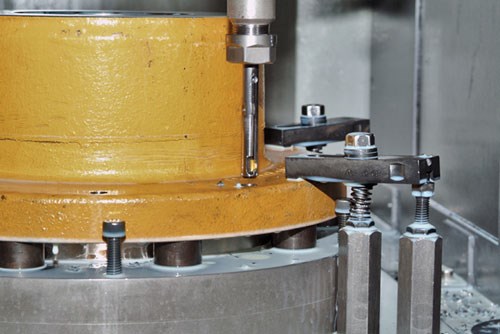Efficient Deburring Leads To Improvements
Although burrs may be the last concern that an engineer or machinist thinks about when focusing on a part’s tolerances and production rate, deburring plays a large role in producing a quality product. And when a deburring process becomes cumbersome, time consuming and costly, it is time to reevaluate the operation.
Although burrs may be the last concern that an engineer or machinist thinks about when focusing on a part’s tolerances and production rate, deburring plays a large role in producing a quality product. And when a deburring process becomes cumbersome, time consuming and costly, it is time to reevaluate the operation.
Skyway Precision Inc. (Plymouth, Mich.) realized a new deburring process was in order when its old process became inefficient. As the CNC machine company was trying to live up to its commitment to provide its customers with experienced machining processes and quality products that are delivered on time with an industry-competitive cost, its deburring operation was slowing down the company’s ability to do so.
Featured Content
Established in 1968, Skyway prides itself by making its mark on the preferred supplier list of many major global manufacturers and has forged a positive reputation in the production of machined components, the company says.
Recently, Skyway needed a solution to a deburring challenge: to reach the backside of an 80-lb component. The company asked E-Z Burr Tool Company Inc. for its assistance, since Skyway had worked with the company on several projects in the past. The nodular iron component is an 11.6-inch hub with 22 holes, ten at 0.425-inch diameter and 12 at 1.093-inch diameter. Skyway was removing the 80-lb hub from the Hyundai-Kia Hi-V50D machine and placing it on the workbench to manually deburr the rear of the holes by using a countersinking tool in an air drill. This method proved to be not only clumsy, but also time consuming and expensive.
The weight of the hub required heavy lifting and positioning while performing this secondary operation by hand on the workbench. The extra handling required further man hours and was a challenge to maneuver. In addition, the countersink tool was expensive, and the life of the tool was limited. The tool would wear quickly and required re-sharpening or replacing often. This extra operation was an added cost to the machining process.
The E-Z Burr carbide series tool offered Skyway a variety of options designed to deburr the rear of the holes while the hub was still in the machine. "While we have a standard selection of diameters and lengths available off the shelf, we designed a special 9-inch-long tool for this unique application," says Bill Robinson, president of E-Z Burr. "The tool was tested at 550 rpm at 8.8 ipm to accommodate the company’s specifications."
For the smaller holes on the hub, a standard length tool at 1,750 rpm at 11 ipm is used to deburr both the top and bottom all in one economical pass. Skyway prefers to use the more aggressive carbide insert that is also a standard option. The increased angles and positive cutting features provide the right amount of pressure and engagement to produce the desired chamfer.
The introduction of the E-Z Burr tool to this process eliminates the need to remove the part from the machine to deburr the rear of the holes. The danger and additional manpower is dramatically reduced with the new process. In addition, the time spent using the countersinking tool and the cost associated with the tool are eliminated and result in more profit to the bottom line.
Eliminating the need to remove and transfer the part created a safer working condition and better job quality for the machine operators, allowing the operator to focus on performance while meeting production schedules.
This solution led to productivity, saving Skyway 15 to 20 minutes per part. While the countersinking tool lasted a day or two, the E-Z Burr carbide insert runs a month before needing to be replaced. The tool itself remains in the machine while the insert is being replaced, adding to the ease of use and gained efficiency in manufacturing.
This process was followed by further engineered improvements by using a short pilot drill to start the hole and chamfer the top of the large holes. The pilot hole eliminates the "walking" and breakage problems and prolongs the life of the expensive long drill while performing its function.
"E-Z Burr gets involved with our customers to solve production problems where deburring parts are an important measure in the final product," says Mr. Robinson. "Problems should not be a roadblock, and time is a precious commodity in production. We have the ability to accommodate tight timelines of days or weeks. The particular tool we customized for Skyway was designed and delivered in less than 2 weeks."
.jpg;maxWidth=970;quality=90)








.jpg;maxWidth=970;quality=90)